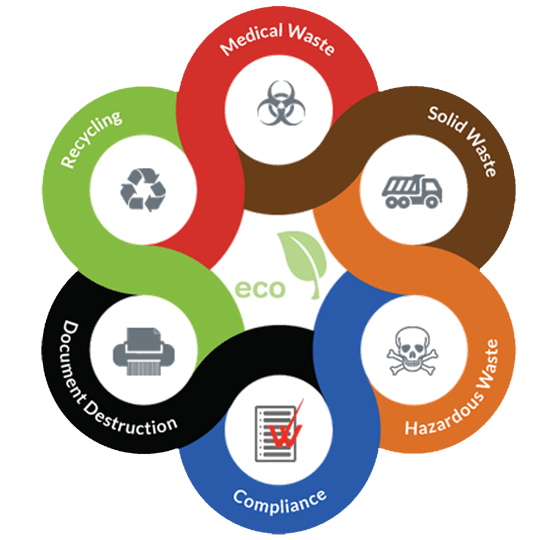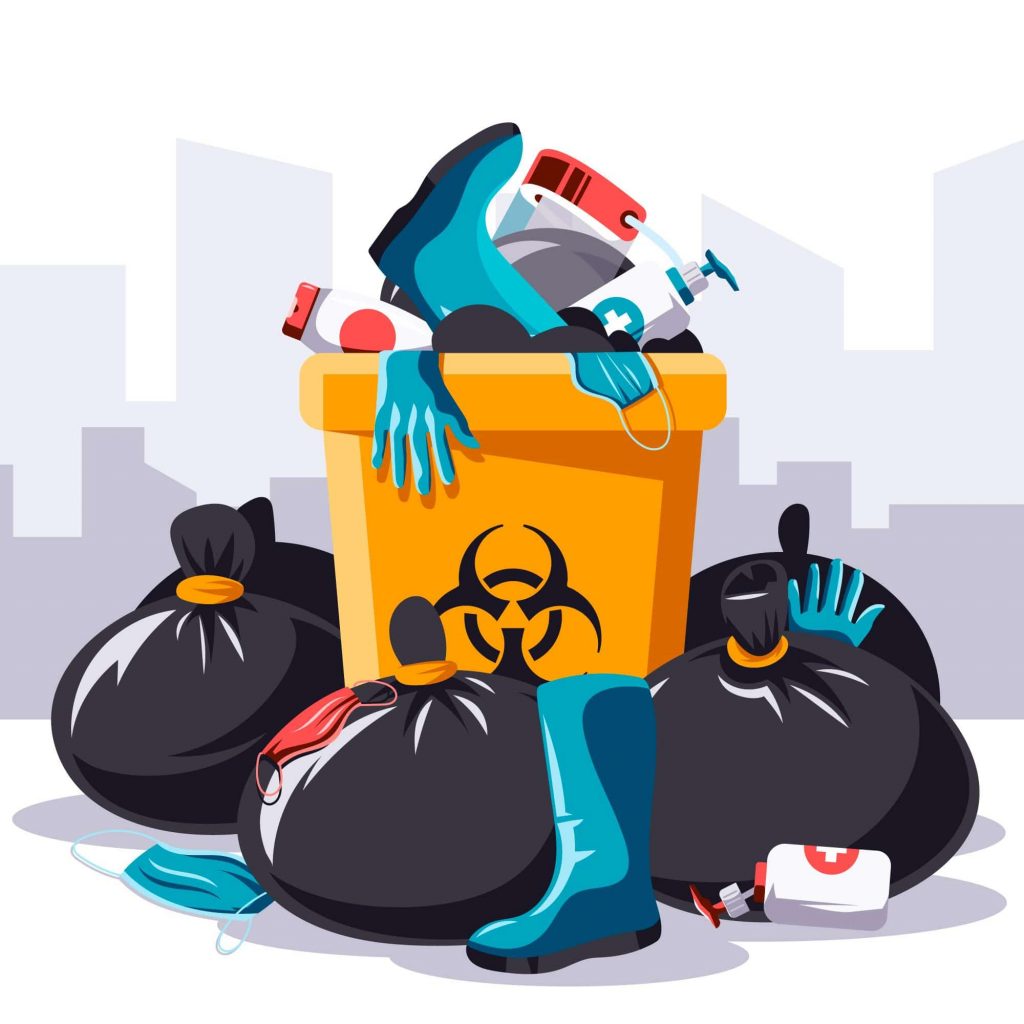Strategic Medical Waste Disposal Solutions: Encouraging Security and Sustainability
Wiki Article
Compliance and Regulations for Medical Garbage Disposal
Compliance and laws for medical garbage disposal play an essential duty in ensuring the security and health of both healthcare specialists and the public. Proper administration of clinical waste is vital to protect against the spread of infections, safeguard the atmosphere, and maintain public health and wellness. This calls for adherence to particular guidelines and methods set forth by regulative companies and bodies. These regulations incorporate numerous elements, consisting of the classification and segregation of medical waste, correct storage space and managing procedures, in addition to transportation and disposal approaches. By complying with these laws, health care centers can minimize the danger of contamination and possible injury to individuals and the atmosphere. This write-up will check out the relevance of compliance and offer a review of the key guidelines controling clinical waste disposal.Relevance of Conformity
The relevance of conformity with regulations for medical garbage disposal can not be overstated. Proper disposal of medical waste is crucial for ensuring the safety and well-being of healthcare workers, patients, and the public. Clinical waste, which consists of products such as utilized needles, contaminated gloves, and biomedical waste, can position major health threats otherwise managed and taken care of effectively.Conformity with policies makes sure that medical waste is taken care of in a manner that reduces the potential for direct exposure to contagious diseases and harmful materials - medical waste disposal. It helps protect against the spread of infections, such as HIV, hepatitis B and C, and various other bloodborne microorganisms. Compliance likewise plays an important duty in safeguarding the environment by stopping contamination of water sources, dirt, and air
Failure to adhere to laws can lead to severe consequences for medical care centers, including penalties, legal action, and damages to their credibility. Furthermore, non-compliance might endanger the health and wellness and safety and security of medical care employees, individuals, and the neighborhood.
Compliance with guidelines for clinical waste disposal needs adherence to certain standards and procedures. These might consist of correct segregation, product packaging, labeling, and storage of clinical waste. It additionally includes utilizing authorized disposal methods, such as incineration, autoclaving, or landfilling, depending on the sort of waste.
Regulatory Agencies and Bodies
Governing companies and bodies play an important duty in overseeing conformity with laws for clinical garbage disposal. These organizations are responsible for setting standards, protocols, and standards to make certain the appropriate and risk-free handling of clinical waste. They monitor and apply conformity to secure public health and wellness and the setting.Among one of the most popular regulatory firms in the USA is the Epa (EPA) The EPA is liable for controling the storage, transportation, therapy, and disposal of clinical waste. They develop standards for waste generators, carriers, and therapy facilities to comply with, making certain that all necessary precautions are taken to protect against the spread of conditions and contamination.
Another important regulative body is the Occupational Security and Health Management (OSHA) OSHA sets criteria and laws to secure workers from work threats, consisting of those pertaining to clinical waste. WasteX Medical Waste Disposal. They provide standards for the risk-free handling and disposal of medical waste to protect workers in healthcare centers
Along with these government agencies, individual states also have their very own regulative bodies that manage clinical garbage disposal. These firms may have their own specific laws and requirements that have to be adhered to.

Classification and Segregation of Medical Waste
To ensure correct monitoring of medical waste, it is important to classify and segregate it according to developed standards and procedures. medical waste disposal service. Category and partition play a crucial function in reducing the danger of infection, securing the atmosphere, and guaranteeing the safety of medical care employees and the publicClinical waste is identified into various categories based on its potential danger level. These categories consist of transmittable waste, pathological waste, sharps waste, pharmaceutical waste, chemical waste, and radioactive waste. Each category requires particular handling, disposal, storage, and transportation methods to reduce the threat of exposure and contamination.
Segregation of medical waste entails separating different kinds of waste at the source. This procedure makes sure that waste with different risk levels is not mixed, decreasing the potential for cross-contamination and making disposal procedures more efficient. Proper segregation is attained with the use of color-coded tags and containers, which help healthcare workers and waste monitoring employees recognize and take care of each kind of waste correctly.
Along with category and segregation, healthcare facilities must likewise comply with regional, state, and government laws concerning medical waste administration. These laws outline details needs for storage, transport, therapy, and last disposal of clinical waste, ensuring compliance and keeping public wellness and safety and security.
Appropriate Storage Space and Managing Treatments
Appropriate storage space and managing procedures play an essential function in guaranteeing the certified and safe management of clinical waste. Medical waste, which consists of items such as used syringes, infected gloves, and ended drugs, can pose severe health and wellness and ecological risks if not managed correctly. Consequently, it is vital for health care centers and various other generators of medical waste to carry out stringent storage space and managing protocols.
To start with, clinical waste ought to be saved in resilient, watertight containers that are specifically created for this purpose. These containers ought to be classified with the universal biohazard sign and words "medical waste" to clearly show the contents. Furthermore, the containers must be kept safely shut to prevent any type of prospective leakage or spillage.
In addition, it is very important to set apart various sorts of clinical waste to protect against cross-contamination. Sharps, such as scalpels and needles, should be stored in puncture-resistant containers to reduce the threat of injuries - WasteX Medical Waste Disposal. Chemical waste, such as solvents and anti-bacterials, should be stored separately from other kinds of medical waste to avoid harmful direct exposures or chemical responses

Transportation and Disposal Methods
Healthcare centers have to make sure the risk-free transport and correct disposal of their medical waste to abide by laws and secure public health and wellness. Transportation and disposal methods play an essential duty in stopping the spread of contagious diseases Recommended Site and decreasing the ecological effect of clinical waste.
To move medical waste, medical care centers should make use of watertight and puncture-resistant containers that are classified with the biohazard sign. These containers should be safely sealed to avoid any type of leakage throughout transportation. In addition, healthcare centers should develop procedures for the transport process, including making use of skilled personnel and specialized vehicles.
When the clinical waste gets to the disposal center, it undergoes various techniques of therapy - WasteX Medical Waste Disposal. One typical approach is incineration, which entails melting the waste at high temperatures to destroy microorganisms and minimize the quantity of waste.
It is necessary for medical care centers to function with licensed and permitted waste management companies to guarantee appropriate transportation and disposal of medical waste. These business have the proficiency and resources to handle medical waste safely and in conformity with guidelines.
Final Thought
To conclude, compliance with regulations for clinical garbage disposal is of utmost value to make sure public health and wellness and safety. Regulatory firms and bodies play a critical duty in implementing these policies. Proper category and partition of medical waste, as well as adhering to proper storage and taking care of treatments, are necessary to avoid contamination and the spread of conditions. Appropriate transportation and disposal methods need to be executed to minimize ecological impacts. On the whole, adherence to conformity and regulations is essential to efficiently manage clinical waste.Medical waste, which includes items such as used needles, infected gloves, and biomedical waste, can present major wellness threats if not taken care of and disposed of appropriately.
These categories consist of contagious waste, pathological waste, sharps waste, pharmaceutical waste, chemical waste, and radioactive waste.Segregation of clinical waste includes dividing different types of waste at the source. Appropriate partition is accomplished through the usage of color-coded labels and containers, which aid health care workers and waste management workers manage each type and determine of waste correctly.
Chemical waste, such as disinfectants and solvents, ought to be saved independently from various other kinds of medical waste to prevent unsafe exposures or chemical reactions.
Report this wiki page